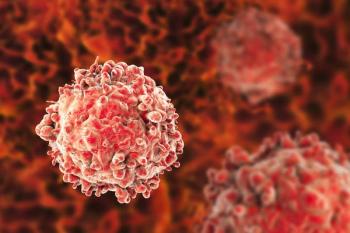
Top 10 Highlights from ASCO 2015
This slide show highlights some of the top studies and news on cancer to come out of the 2015 American Society of Clinical Oncology (ASCO) Annual Meeting, held in Chicago.
References:
1. Wolchok JD, Chiarion-Sileni V, Gonzalez R, et al. Efficacy and safety results from a phase III trial of nivolumab (NIVO) alone or combined with ipilimumab (IPI) versus IPI alone in treatment-naive patients (pts) with advanced melanoma (MEL) (CheckMate 067). Presented at the 2015 American Society of Clinical Oncology Annual Meeting; May 29-June 2, 2015; Chicago. Abstract LBA1.
2. Brown PD, Asher AL, Ballman KV, et al. NCCTG N0574 (Alliance): A phase III randomized trial of whole brain radiation therapy (WBRT) in addition to radiosurgery (SRS) in patients with 1 to 3 brain metastases. Presented at the 2015 American Society of Clinical Oncology Annual Meeting; May 29-June 2, 2015; Chicago. Abstract LBA4.
3. Le DT, Uram JN, Wang H, et al. PD-1 blockade in tumors with mismatch repair deficiency. Presented at the 2015 American Society of Clinical Oncology Annual Meeting; May 29-June 2, 2015; Chicago. Abstract LBA100.
4. Sandler HM, Hu C, Rosenthal SA, et al. A phase III protocol of androgen suppression (AS) and 3DCRT/IMRT versus AS and 3DCRT/IMRT followed by chemotherapy (CT) with docetaxel and prednisone for localized, high-risk prostate cancer (RTOG 0521). Presented at the 2015 American Society of Clinical Oncology Annual Meeting; May 29-June 2, 2015; Chicago. Abstract LBA5002.
5. Turner NC, Ro J, Andre F, et al. PALOMA3: A double-blind, phase III trial of fulvestrant with or without palbociclib in pre- and post-menopausal women with hormone receptor-positive, HER2-negative metastatic breast cancer that progressed on prior endocrine therapy. Presented at the 2015 American Society of Clinical Oncology Annual Meeting; May 29-June 2, 2015; Chicago. Abstract LBA502.
6. Schöffski P, Maki RG, Italiano A, et al. Randomized, open-label, multicenter, phase III study of eribulin versus dacarbazine in patients (pts) with leiomyosarcoma (LMS) and adipocytic sarcoma (ADI). Presented at the 2015 American Society of Clinical Oncology Annual Meeting; May 29-June 2, 2015; Chicago. Abstract LBA10502.
7. Chanan-Khan AAA, Cramer P, Demirkan F, et al. Ibrutinib combined with bendamustine and rituximab (BR) in previously treated chronic lymphocytic leukemia/small lymphocytic lymphoma (CLL/SLL): First results from a randomized, double-blind, placebo-controlled, phase III study. Presented at the 2015 American Society of Clinical Oncology Annual Meeting; May 29-June 2, 2015; Chicago. Abstract LBA7005.
8. D’Cruz A, Dandekar M, Vaish R, et al. Elective versus therapeutic neck dissection in the clinically node negative early oral cancer: A randomised control trial (RCT). Presented at the 2015 American Society of Clinical Oncology Annual Meeting; May 29-June 2, 2015; Chicago. Abstract LBA3.
9. Armstrong GT, Yasui Y, Chen Y, et al. Reduction in late mortality among 5-year survivors of childhood cancer: A report from the Childhood Cancer Survivor Study (CCSS). Presented at the 2015 American Society of Clinical Oncology Annual Meeting; May 29-June 2, 2015; Chicago. Abstract LBA2.
10. Margolese RG, Cecchini RS, Julian TB, et al. Primary results, NRG Oncology/NSABP B-35: A clinical trial of anastrozole (A) versus tamoxifen (tam) in postmenopausal patients with DCIS undergoing lumpectomy plus radiotherapy. Presented at the 2015 American Society of Clinical Oncology Annual Meeting; May 29-June 2, 2015; Chicago. Abstract LBA500.
Newsletter
Stay up to date on recent advances in the multidisciplinary approach to cancer.
































































































